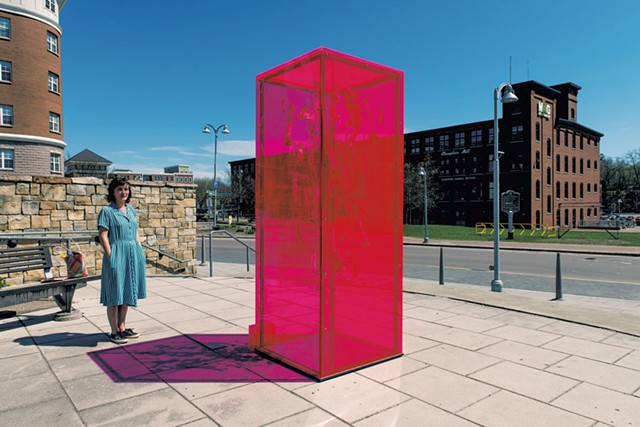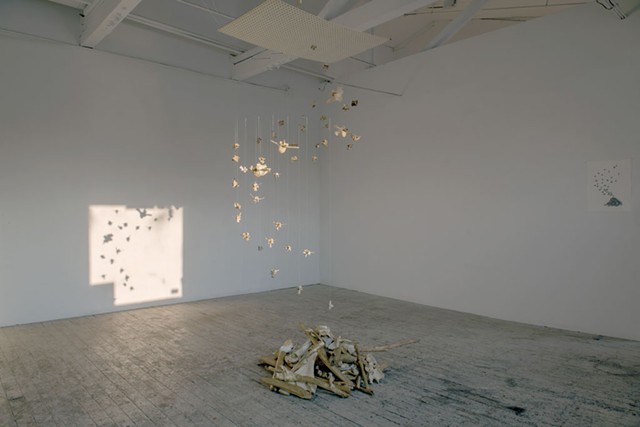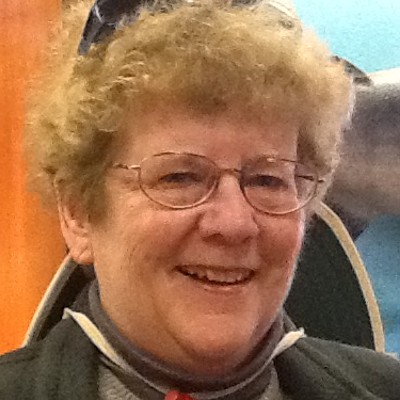
- Courtesy Of Daniel James Cardon
- "Perpetual Light" by Lydia Kern
Burlington's biggest art event of the year, the South End Art Hop, is this weekend, September 7 through 9. According to the South End Arts and Business Association, which organizes and presents the Hop, the event draws some 30,000 people annually. For better or worse, it seems to be an opportunity to experience art, not necessarily to purchase it. Conversations with artists at past Hops suggest that's a sore subject for some. But others, such as emerging artist Lydia Kern, revel in the opportunity to create singular installations that will entrance viewers all weekend.
In May 2015, Kern, 26, graduated from the University of Vermont, where she studied social work and studio art. Every year since, she has created sparkly, slightly disturbing installation sculptures for Art Hop. Her practices are multiple: Besides being a performance and installation artist, she's a sculptor. And she makes prints.
Kern's first series of "glitter bones" — animal bones lacquered with gold glitter — appeared at Pine Street Studios during the 2015 Art Hop. The following year, her "Glitterbox" was installed at 8 Space Studio collective. The interior of the massive box was lined with golden, glitter-encrusted strings. At the bottom, a mirror invited the viewer to peer into the shiny construction.
Perhaps Kern's most memorable Art Hop installation was last year's "Fleet," a series of vertebrae suspended with fishing line from the ceiling of the Hive Collective. The juddering bones and their corresponding shadows (manipulated by a fan placed on the floor of the well-lit room) created a peaceful yet unsettling effect.
Part of what makes Kern's work exciting is how approachable and enchanting it is. Glitter! Mirrors! It's designed to fascinate, to draw you closer. At the same time, her process involves unearthing decomposed animal corpses and harvesting bones. The combination of attraction and repulsion invites us to examine the contradictions and codependency of life's many emotions.
Kern will show her art in three locations this Art Hop. Work from her residency at the Vermont Studio Center will be on display at the Hive Collective, while her sculpture "Perpetual Light" (previously shown at Waking Windows in Winooski) has been installed in front of Burlington Electric Department. She'll also participate in a group show curated by Caitlin La Dolce at Pine Street Studios. Seven Days met with the artist to talk about her process.

- Courtesy Of Daniel James Cardon
- "Fleet" by Lydia Kern
SEVEN DAYS: You're installing works in three different locations this year, which is new. What part are you excited for?
LYDIA KERN: The show that Caitlin La Dolce curated at Pine Street Studios feels extra exciting because of the relationships I have with the other female artists. It's called "What They Didn't Notice." I'm creating that work this week. There's a lot of accountability and mutual support between us that encourages each of our individual processes; it's an ecosystem of artistic and personal support. And for Caitlin to rally us together and put our work together in the same room feels meaningful.
SD: It seems like interpersonal relationships are important to your work process in general; often people rally to help you install or take video, or you're printing with a friend. What about those interactions is important to you?
LK: When I started making work, it was the only thing that made sense in the world. I lost my sister in January 2015, and I graduated in May 2015, and everyone is like, "What are you doing after college?" These structures, my sculptures, have been things that help me understand my own internal structures, and how I process and move through the world. It's also been a medium for connection. Being an artist in this town, and having collaborative support and building relationships and artistic solidarity, is indispensible and irreplaceable. It got me through these years.
It's really interesting to be in a place in my life where I'm no longer in a survival zone that I started making art out of. So now I'm navigating how much to share about that and how much to not, because my work is personal, but I have no interest in making it about me. It's an experience for all of us to share and talk about.
SD: You go to some extreme lengths to uncover and process bones from compost piles. Why is it so important to you to do that?
LK: Sometimes the process is very easy. I can't tell you how many times I just get boxes of bones in the mail from friends. If anyone broke into my car, they would be so concerned because of all the bones. But the process is deeply important to me. Part of what I love about making large, inconvenient objects that require a lot of space is that I really appreciate physical work.
I've always found a lot of significance in the process of uncovering things, and the compost pile — a lot of simple truths in natural life cycles, or the process of materials. If something dies, and you bury it in the ground, the only thing that turns it from one thing into the other is time. It's unbelievable.
Our culture loves putting a Band-Aid on things and isn't comfortable interfacing with death and things that are difficult to talk about, like trauma. Well, let's uncover it. Let's unearth it. Let's look at this cow carcass.
SD: What are some of the potential pitfalls of making such highly public work as a young artist?
LK: We're so quick to define things in our culture, this culture of instant self-publishing. I'm really repelled by that. But people want labels to understand things. How easy is it for me to become "the bone lady" in all that? When you make work, it's really easy to respond to people's responses and not the work. I'm always grappling with that. I could keep making plexiglass boxes, but the point is not the box. My process will die if I think I know what I'm doing.









Comments
Comments are closed.
From 2014-2020, Seven Days allowed readers to comment on all stories posted on our website. While we've appreciated the suggestions and insights, right now Seven Days is prioritizing our core mission — producing high-quality, responsible local journalism — over moderating online debates between readers.
To criticize, correct or praise our reporting, please send us a letter to the editor or send us a tip. We’ll check it out and report the results.
Online comments may return when we have better tech tools for managing them. Thanks for reading.